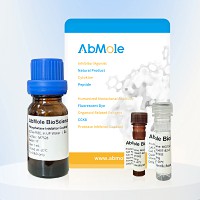All AbMole products are for research use only, cannot be used for human consumption.

Beta1,4-Galactosyltransferase-I (B4GALT1), one of seven beta1,4-galactosyltransferases, is an enzyme commonly found in the trans-Golgi complex that adds galactose to oligosaccharides. By sequence similarity, the beta 4GalTs form four groups: beta 4GalT1 and beta 4GalT2, beta 4GalT3 and beta 4GalT4, beta 4GalT5 and beta 4GalT6, and beta 4GalT7. beta 4GalT1 is unique among the seven enzymes because it can be expressed either as membrane associated form or secreted form. The secreted form is restricted to lactating mammary tissues where the enzyme forms a heterodimer with alpha -lactalbumin to catalyze the synthesis of lactose. The Golgi complex form catalyzes the production of lactose in the lactating mammary gland and could also be responsible for the synthesis of complex-type N-linked oligosaccharides in many glycoproteins as well as the carbohydrate moieties of glycolipids. The cell surface form functions as a recognition molecule during a variety of cell to cell and cell to matrix interactions, as those occurring during development and egg fertilization, by binding to specific oligosaccharide ligands on opposing cells or in the extracellular matrix. Defects in beta 4GalT1 are the cause of congenital disorder of glycosylation type 2D (CDG2D).
Recombinant Human Beta-1,4-galactosyltransferase 1 expressed the target gene encoding Gly44-Ser398(Tyr285Leu) with a 6His tag at the C-terminus.
Supplied as a 0.2 μm filtered solution of 20mM Tris-HCl, 150mM NaCl, 2mM EDTA, 20% Glycerol, pH 8.0.
The product is shipped on dry ice packs. Upon receipt, store it immediately at the temperature listed below.
| Form | Solution |
| Storage | Store at ≤-70°C, stable for 6 months after receipt. Please minimize freeze-thaw cycles. |
[2] Daniel Taliun, et al. Nature. Sequencing of 53,831 diverse genomes from the NHLBI TOPMed Program
| Related Cytokines and Growth Factors Products |
|---|
| Recombinant Human GDF-15 Protein (HEK293 N-hFc)
Growth-differentiation factor 15 (GDF15), also known as MIC-1, is a secreted member of the transforming growth factor (TGF)-β superfamily. GDF-15 has a role in regulating inflammatory and apoptotic pathways in injured tissues and during disease processes. GDF-15 overexpression arising from an expanded erythroid compartment contributes to iron overload in thalassemia syndromes by inhibiting hepcidin expression. |
| Recombinant Human FGFR1 Protein (HEK293, C-His)
FGFR1, also known as CD331, is a full-length representative protein consists of an extracellular region, composed of three immunoglobulin-like domains, a single hydrophobic membrane-spanning segment and a cytoplasmic tyrosine kinase domain. |
| Recombinant Human FGFR2 Protein (HEK293, C-His)
FGFR2, also known as CD332, acts as cell-surface receptor for fibroblast growth factors and plays an essential role in the regulation of cell proliferation, differentiation, migration and apoptosis, and in the regulation of embryonic development. FGFR2 plays an essential role in the regulation of osteoblast differentiation, proliferation and apoptosis, and is required for normal skeleton development. It also promotes cell proliferation in keratinocytes and imature osteoblasts, but promotes apoptosis in differentiated osteoblasts. |
| Recombinant Mouse BMP-4 Protein (E. coli, C-His)
Bone Morphogenetic Protein-4 (BMP-4) is a critical signaling molecule required for the early differentiation of the embryo and establishing of a dorsal-ventral axis. BMP-4 is secreted from the dorsal portion of the notochord, and it acts in concert with sonic hedgehog to establish a dorsal-ventral axis for the differentiation of later structures. |
| Recombinant Human Coagulation Factor X (HEK293, C-Fc)
Coagulation factor X, belongs to the peptidase S1 family. Coagulation factor X is initially synthesized in the liver. Coagulation factor X is a vitamin K-dependent glycoprotein that converts prothrombin to thrombin in the presence of factor Va, calcium and phospholipid during blood clotting. |
All AbMole products are for research use only, cannot be used for human consumption or veterinary use. We do not provide products or services to individuals. Please comply with the intended use and do not use AbMole products for any other purpose.


Products are for research use only. Not for human use. We do not sell to patients.
© Copyright 2010-2024 AbMole BioScience. All Rights Reserved.
